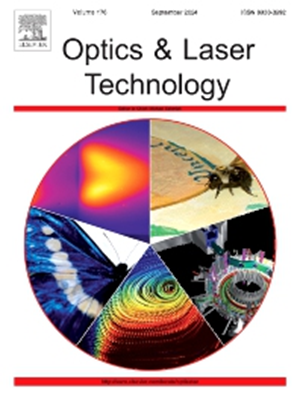基于热应力诱导整体剥离策略的铝合金涂层激光清洗优化研究
IF 4.6
2区 物理与天体物理
Q1 OPTICS
引用次数: 0
摘要
在铝合金飞机外壳激光除漆过程中,阳极氧化膜容易受到损伤。针对这一问题,我们提出了一种名为热应力诱导整体剥离(TSIP)的清洗策略。在此策略的指导下,我们利用红外纳秒脉冲激光器进行了激光除漆实验。清洗表面的微观形貌、元素组成、腐蚀电流密度(5.4 × 10−7 A/cm2)和接触角(70.28°)与原始氧化膜高度一致,表明成功实现了最佳清洗。结合宏微观形貌分析和热力学模拟,揭示了氧化膜损伤机理。涂料层底部的热应力超过其断裂强度,导致其碎裂,脱离表面,形成孔洞。随后的脉冲穿过这些孔直接照射氧化膜,从而破坏氧化膜。通过热应力模拟得到最佳清洗工艺窗口为2.32 ~ 3.20 J/cm2,与实验结果吻合较好。该研究为优化清洗提供了一种新的方法,有助于推进激光除漆技术在飞机表面的工程应用。本文章由计算机程序翻译,如有差异,请以英文原文为准。
Optimised laser cleaning of paint from aluminum alloy based on thermal stress-induced integral peeling strategy
The anodic oxide film is susceptible to damage during laser paint removal of aluminum alloy aircraft skins. In response to this issue, we proposed a cleaning strategy named Thermal Stress-Induced Integral Peeling (TSIP). Under the guidance of this strategy, we conducted laser paint removal experiments using an infrared nanosecond pulsed laser. The microscopic morphology, elemental composition, corrosion current density (5.4 × 10−7 A/cm2), and contact angle (70.28°) of the cleaned surface were highly consistent with the original oxide film, indicating that optimum cleaning was successfully realized. Furthermore, the oxide film damage mechanism was revealed by combining macro/micro morphology analysis and thermo-mechanical simulation. The thermal stress at the bottom of the paint layer exceeds its fracture strength, causing it to fragment and detach from the surface, forming holes. Subsequent pulses then pass through these holes to directly irradiate the oxide film, thereby damaging it. The process window for optimum cleaning, obtained through thermal stress simulation, is 2.32–3.20 J/cm2, which is in good agreement with the experimental results. The research provides a new approach for optimum cleaning and contributes to advancing the engineering application of laser paint removal on aircraft skins.
求助全文
通过发布文献求助,成功后即可免费获取论文全文。
去求助
来源期刊
CiteScore
8.50
自引率
10.00%
发文量
1060
审稿时长
3.4 months
期刊介绍:
Optics & Laser Technology aims to provide a vehicle for the publication of a broad range of high quality research and review papers in those fields of scientific and engineering research appertaining to the development and application of the technology of optics and lasers. Papers describing original work in these areas are submitted to rigorous refereeing prior to acceptance for publication.
The scope of Optics & Laser Technology encompasses, but is not restricted to, the following areas:
•development in all types of lasers
•developments in optoelectronic devices and photonics
•developments in new photonics and optical concepts
•developments in conventional optics, optical instruments and components
•techniques of optical metrology, including interferometry and optical fibre sensors
•LIDAR and other non-contact optical measurement techniques, including optical methods in heat and fluid flow
•applications of lasers to materials processing, optical NDT display (including holography) and optical communication
•research and development in the field of laser safety including studies of hazards resulting from the applications of lasers (laser safety, hazards of laser fume)
•developments in optical computing and optical information processing
•developments in new optical materials
•developments in new optical characterization methods and techniques
•developments in quantum optics
•developments in light assisted micro and nanofabrication methods and techniques
•developments in nanophotonics and biophotonics
•developments in imaging processing and systems

 求助内容:
求助内容: 应助结果提醒方式:
应助结果提醒方式:


